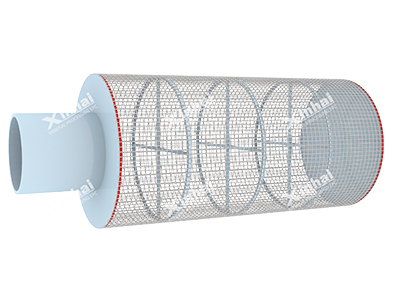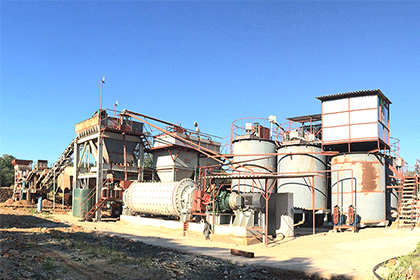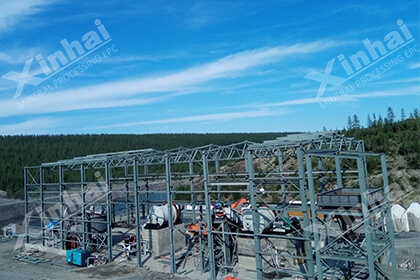Gold Heap Leaching Process Technical Requirements
 Shirley
Shirley
 Jun 25, 2021
Jun 25, 2021
 1874
1874
If you want to know more details about equipment, solutions, etc, please click the button below for free consultation, or leave your requirements!

Gold heap leaching process refers to the process of stacking low-grade gold ore or flotation tailings on the bottom material, and spraying the sodium cyanide solution circularly to dissolve the gold in the ore and recover it from the gold-containing pregnant liquid. Gold heap leaching process mainly consists of heap leaching site construction, ore pretreatment (crushing or granulation), pile building, spray leaching, gold recovery from gold-bearing pregnant liquid, disinfection and unloading of waste ore piles, etc.
In the leaching process, it is necessary to control a number of parameters to obtain good beneficiation effect. This article will take you to understand the technical requirements in granulation, stacking and spraying.
01 Granulation
BackTo make the gold heap leaching process successful, the heap leaching material must have good permeability so that the cyanide solution can evenly pass through the ore pile. Most ores need to be crushed to 25.4mm or finer before granulation in order to expose the gold contained in the ore and improve the gold recovery rate.
During the granulation process, the amount of lime must reach a pH value between 9.5-10.5. Due to the high humidity of the ore (the water content is above 10%) and the ore contains many impurities, the concentration of sodium cyanide should be increased during granulation, and the concentration of sodium cyanide should be controlled at about 60-150 grams per ton of gold ore. The total moisture content of the pellet is generally not more than 30%, otherwise the pellet is easy to loose and soft. The curing time should be more than 72 hours. If it rains while pelletizing, the grains must be covered to prevent gold loss.
02 Stacking
BackGold heap leaching sites can be placed on slopes, valleys or flat ground, but for flat ground requires a slope of 3% to 5%. The height of the ore pile should not be too high at first, preferably 3-4 meters, and it can be increased later when the leaching rate is stable.
After cleaning and leveling the ground, seepage prevention treatment is required. In order to protect the mine piles, flood drainage ditches should also be set around the heap leaching site. The cushion layer of the heap leaching field can be laid on the compacted foundation with a layer of about 0.5m thick, and then sprayed with sodium carbonate solution on it to enhance its anti-seepage performance.
03 Spraying
Back#1 Spray Concentration
The agglomerated ore particles that have been granulated must not be washed again and the pH value should be adjusted through washing. The pH value should be adjusted during the granulation. Due to the complex composition of the gold ore, the concentration of sodium cyanide during the initial spraying can be appropriately increased, which can be controlled within 0.1%-0.08% After the peak period (when the leaching gold concentration is the highest), it can be reduced to 0.08%-0.06%. In the later stage, it can be reduced to 0.04%-0.02%. The sodium cyanide concentration can be adjusted at any time according to the gold concentration of the pregnancy liquid.
#2 Spray Cycle
The spraying time is generally 7-8 hours a day, and cannot exceed 10 hours at most (but the amount should be reduced). Generally, spray 1 stop 1 or spray 1 stop 2. Spraying time should not be too long, so that the ore pile can breathe oxygen when it is not sprayed. If the spraying time is long and many times, it will increase the volume of the solution, reduce the concentration of pregnant solution and waste sodium cyanide. At the same time, it will increase the volume of the pregnant solution and affect the adsorption capacity of the gold-loaded carbon.
#3 Spray Intensity
Spray intensity is related to spray time and spray volume. Generally, the spray intensity should be controlled at 6-20L/m2•h (6-20L/m2×hour), and the maximum should not exceed 25-30L/m2•h (can be calculated according to the storage yard area, daily spraying liquid amount and time). If the spray intensity is large, the volume of the pregnant liquid will increase, and the gold concentration will be diluted, which will affect the adsorption capacity of activated carbon (generally, the adsorption capacity of activated carbon is 8-10kg/t). If the expensive liquid volume is large, in the same adsorption time, due to the low concentration of gold, the adsorption amount is reduced, the adsorption time is extended, which will also increase the workload and cost of the desorption electrolysis system. Therefore, the spray volume cannot be too large, and the spray frequency cannot be too much.
04To Wrap Up
BackThe above are the technical requirements of the gold heap leaching process in the granulation, stacking, and spraying. Gold heap leaching method is widely used because of its simple process, less equipment, low cost, etc. In actual production, each mine owner should pay attention to controlling the parameters of each link to ensure good leaching results.
If you want to learn more about gold extraction by heap leaching process, welcome to submit a message or consult our online customer service.
 +86 18716000713
+86 18716000713 xlyin@xinhaimining.net
xlyin@xinhaimining.net




 Message
Message Chat Now
Chat Now



















